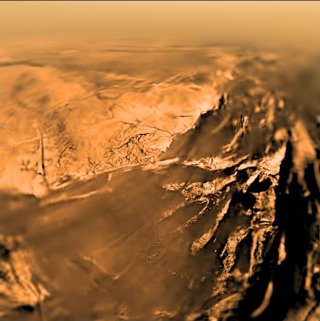 Centauri Dreams has great pleasure in recommending new movie views of the landing of the Huygens probe on Titan, released yesterday by NASA, the European Space Agency and the University of Arizona. The first sequence, titled “View from Huygens on Jan. 14, 2005” offers a spectacular four-minute ride that compresses what would have been seen by the probe during its 2.5 hour descent, using data gathered by the Descent Imager/Spectral Radiometer instrument aboard Huygens.
Centauri Dreams has great pleasure in recommending new movie views of the landing of the Huygens probe on Titan, released yesterday by NASA, the European Space Agency and the University of Arizona. The first sequence, titled “View from Huygens on Jan. 14, 2005” offers a spectacular four-minute ride that compresses what would have been seen by the probe during its 2.5 hour descent, using data gathered by the Descent Imager/Spectral Radiometer instrument aboard Huygens.
Image: DISR view south at 5 miles above the landing site on Titan, Jan. 14, 2005. (Credits: ESA/NASA/JPL/University of Arizona).
“At first, the Huygens camera just saw fog over the distant surface,” said Erich Karkoschka, team member at the University of Arizona, Tucson, and creator of the movies. “The fog started to clear only at about 60 kilometers [37 miles] altitude, making it possible to resolve surface features as large as 100 meters [328 feet],” he said. “But only after landing could the probe’s camera resolve little grains of sand millions and millions of times smaller than Titan. A movie is a perfect medium to show such a huge change of scale.”
The view is stunning, especially when I think back to astronomy books I read in the 1950s and 60s, when Saturn itself was a fuzzy Palomar image and Titan no more than a bright enigma. To be looking at movies created from actual lander data on a home PC causes this writer to be amazed all over again by the spread of technology from laboratory to spacecraft and into the home. And ponder what will become possible with optical communications technology in the not so distant future.
The second movie is also a stunner; it shows the operating life of the DISR instrument with graphics and sidebar information, with sounds changing to mimic the probe’s rotational speed and the tilt of its parachute, along with parachute deployments, heat shield release, the jettison of the DISR cover and the actual touchdown. The music score for this one tracks the onrush of data and is utterly haunting.
“There’s so much information in the different displays that come with this movie that one can easily miss something important,” said Karkoschka. “Therefore, I added sound to track the most important features, because the ears hear all the sound no matter where you look.”
Wow…


Hi Paul
Amazing views. Does the whole venture justice to produce something so immediate as a (quasi) real-time movie.
Titan is proving weirder than we imagined – who expected dark seas of ‘sand’ dunes? Just what are they made of? One quote says the grains would be like coffee grounds in size. With all the odd hydrocarbony stuff from the atmosphere I wonder.
Apparently Ralph Lorenz reckons there will be lakes in the northern hemisphere, and with all the evident erosion the rains, when they come, must be incredible. But is all the methane just in the atmosphere? Where is venting up from beneath the crust?
Questions, questions.
Adam
Thanks for the info! Unfortunately the video just spiked my curiosity into the hidden Saturn moon.
Although there is evidence that no current oceans of methane exist (very sad as it could have provided an economic insentive to explore), Titan would still be an interesting place to live on.
If only the probe would find the evidence of bacterial life that some of us have come to expect.
Wow! I mean, wow! Another planet, another world. Well, satellite, but who cares? It makes me shiver with excitement when I watch it. Another world, so familiar – a desert somewhere on earth where you can imagine walking, picking up a rock (of ice!), how did that get there, into that place? What forces, what processes placed it there? – but so alien, I’d be dead in a second. Wow!